Making up a third of one of the most important jazz chord progressions (the ii-V-I), dominant 7th chords are essential tools for any jazz guitarist to have under their fingers. In this lesson, you will learn how dominant 7th chords work, how they are formed and why dominant chords are called dominant. You will also learn how to play dominant chords on the guitar and how they are used in jazz and other styles of music.
The term ‘dominant chord’ can refer to two facets that are related to each other:
- It can refer to a chord type.
- It can refer to a harmonic function.
The symbol of a dominant seventh chord is “7” added to the root of the chord.
For example: G dominant 7 = G7
LESSON CONTENTS
How To Construct a Dominant 7th chord
First, we’ll have a look at dominant chords as a chord type.
Let’s make a dominant chord and start from the C major scale:
| C Major Scale | C | D | E | F | G | A | B |
|---|---|---|---|---|---|---|---|
| 1 | 2 | 3 | 4 | 5 | 6 | 7 |
Something to remember:
The dominant chord is built on the 5th scale degree
The 5th scale degree of C major is G, so the dominant chord of C major is G7.
We are going to construct a chord by stacking thirds on G (if this is Chinese to you, do our Chord Theory Lesson first):
| G7 | G | B | D | F |
|---|---|---|---|---|
| 1 | 3 | 5 | b7 |
The dominant chord of C major is G7 and consists of the notes G B D and F.
Dominant chord = major triad + b7
Dominant 7th Chords On The Guitar
Let’s have a look at some dominant chord shapes on the guitar.
Basic Dominant 7th Chords
Here are 5 basic dominant 7 shapes that you should memorize.
Learn to apply them to chord progressions and jazz standards as soon as possible.

Drop 3 Dominant 7 Inversions – E-string Bass Note
To begin our studies of drop 3 dominant chords for jazz guitar, here is the formula for building each inversion.
Once you have these interval patterns memorized you will be ready to apply them to the fretboard by learning the shapes in the chord charts below.
| Drop 3 7 Root Position | 1 | b7 | 3 | 5 |
| Drop 3 7 1st Inversion | 3 | 1 | 5 | b7 |
| Drop 3 7 2nd Inversion | 5 | 3 | b7 | 1 |
| Drop 3 7 3rd Inversion | b7 | 5 | 1 | 3 |
Here are four inversions of C7 drop 3 chords that you can apply to your jazz guitar studies:

Drop 3 Dominant 7 Inversions – A-string Bass Note
When moving on to the next string set for drop 3 7th chords (with the lowest note on the 5th string), you don’t need to learn a new intervallic formula as those intervals remain the same on any string set.
Here are four inversions of that chord for you to learn, practice in 12 keys and apply to your favorite jazz standards.

Drop 2 Dominant 7 Inversions – A-string Bass Note
You can now move on to exploring drop 2 chords by learning how to build the intervals for each inversion.
| Drop 2 7 Root Position | 1 | 5 | b7 | 3 |
| Drop 2 7 1st Inversion | 3 | b7 | 1 | 5 |
| Drop 2 7 2nd Inversion | 5 | 1 | 3 | b7 |
| Drop 2 7 3rd Inversion | b7 | 3 | 5 | 1 |
Here are four inversions of a drop 2 C7 chord on the middle four strings that you can work in the practice room, as well as take to other keys as you move these shapes around the fretboard.

Drop 2 Dominant 7 Inversions – D-string Bass Note
Here are four drop 2 C7 chord shapes on the top four strings/

Dominant Chords With Extensions
A plain dominant chord sounds a bit vanilla, especially in jazz. That’s why we add other notes to dominant chords, to make them more interesting and colorful. The added notes are called tensions or extensions.
Dominant 9 Chords
Interval structure = 1 3 5 b7 9

Dominant 13 Chords
Interval structure = 1 3 5 b7 (9) 13

7Sus4 Chords
Interval structure = 1 4 5 b7
Dominant sus4 chords are something different. In a sus4 chord, the 4th (usually) replaces the 3rd of the dominant chord: G C D F instead of G B D F.
This creates a chord with an open sound. Sus4 chords can act as a delay for dominant chords, as in this example:

Here are three common examples of 7sus4 chords:

9Sus4 Chords
Interval structure = 1 4 5 b7 9
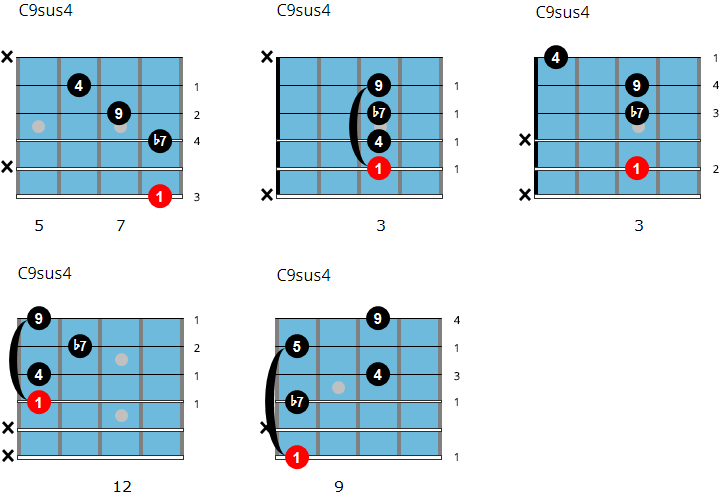
13Sus4 Chords
Interval structure = 1 4 5 b7 (9) 13

Altered Dominant Chords
To bring even more tension to dominant chords, we can “alter” these tension notes, that means lower or raise them by a half tone.
Dominant 7b9
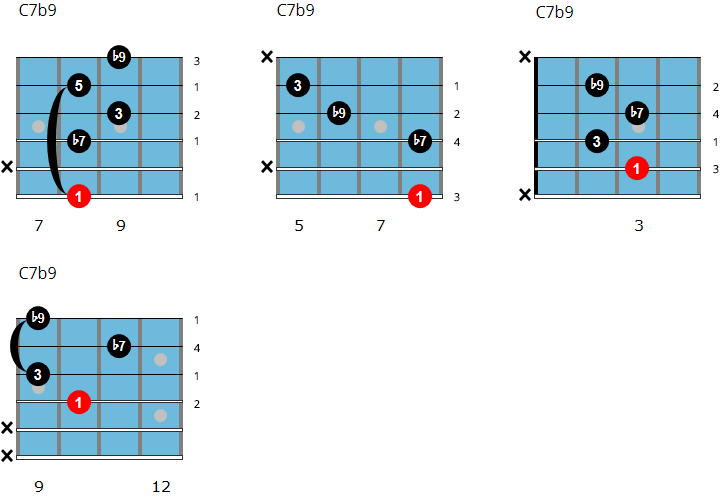
7b9 Sus 4

Dominant 13b9 / Dominant 13#9


Dominant 7#9
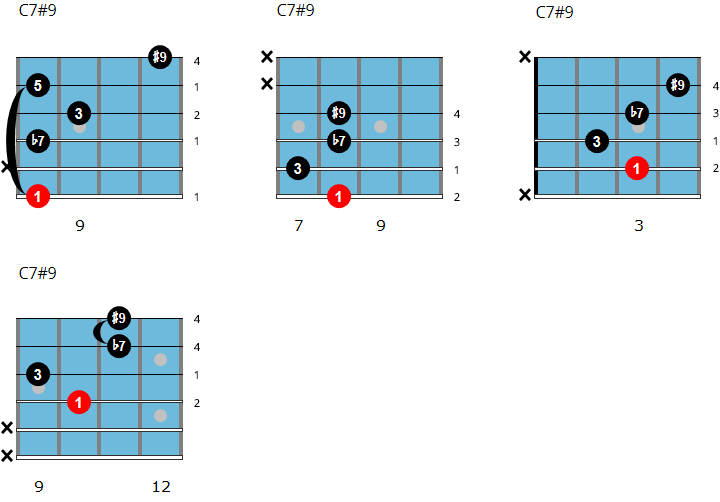
Dominant 7#11
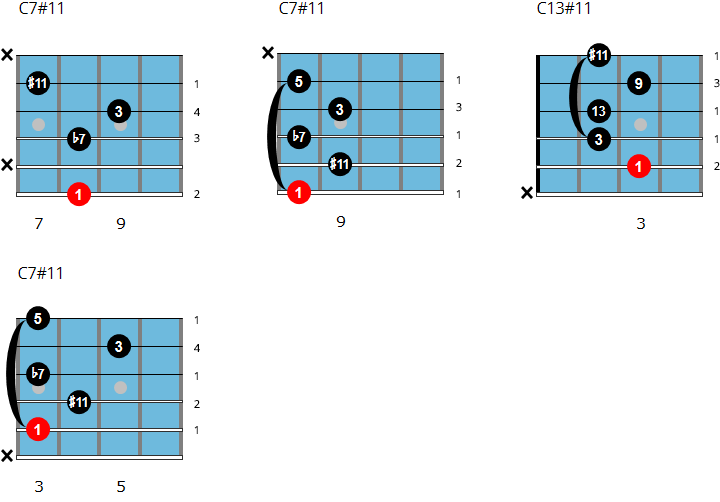
Dominant 7b13
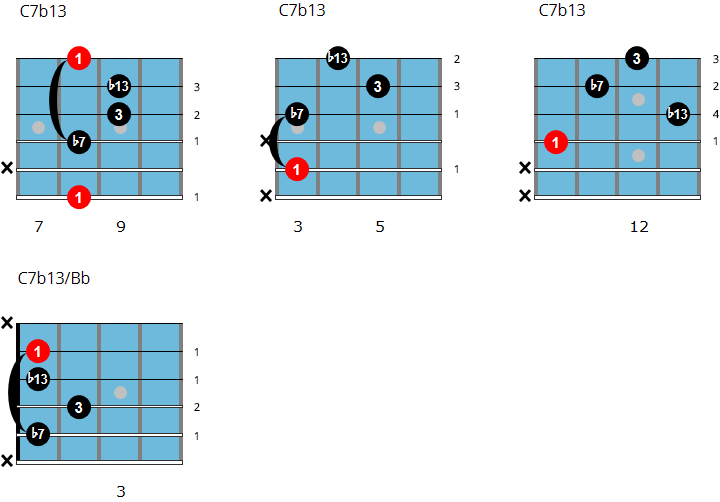
Dominant 7 (b9,b13)

Altered – 7b5(b9)

Altered – 7b5(#9)

Altered – 7#5(b9)

Altered – 7#5(#9)

How Are Dominant Chords Used?
Let’s have a look at the function of the dominant chord family.
Every note and chord in a scale has a diatonic function, a certain role they play in relation to the key.
| Cmaj7 | Dm7 | Em7 | Fmaj7 | G7 | Am7 | Bm7b5 |
|---|---|---|---|---|---|---|
| I | II | III | IV | V | VI | VII |
| Tonic | Subdominant (Supertonic) |
Tonic (Mediant) |
Subdominant | Dominant | Tonic (Submediant) |
Dominant (Leading Tone) |
The most important functions are Tonic, Subdominant, and Dominant:
- Tonic: the first chord in the C major scale (Cmaj7) is called tonic. It is the tonal center and final resolution chord and gives our ears a sense of “musical relaxation” or “being home”.
- Subdominant: the fourth chord (Fmaj7) is called subdominant. It gives our ears a sense of movement, of moving away from the tonic.
- Dominant: the fifth chord (G7) is called dominant. The dominant chord creates tension and instability and wants to resolve to the tonic chord.
Here’s an audio example so you can hear what a dominant chord sounds like.
- We start on Cmaj7, the tonal center.
- The chords move to the subdominant (Fmaj7), moving away from the tonic
- The dominant starts on bar 4 (G13 has the same function as G7). I made the G7 part longer so you can feel the urge to resolve to Cmaj7, which it does in bar 9.
Listen & Play Along
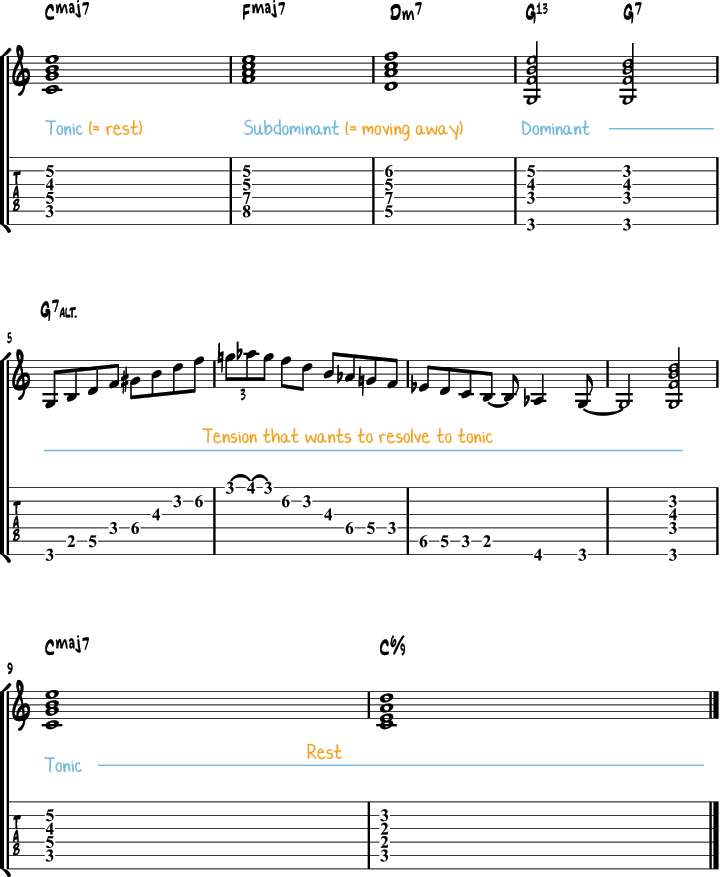
How To Resolve a Dominant Chord?
As you learned in the previous example, a dominant chord resolves to its tonic chord. This is because of voice leading.
The 3 (b) and b7 (f) of G7 form a tritone interval (interval of 6 semi-tones). This is an unstable interval with a lot of dissonance and tension. This tension makes the unstable notes want to move to their nearest neighbor in the key of C major:
- The b7 of G7 (f) wants to resolve to the 3 of C (e)
- The 3 of G7 (b) wants to resolve to the 1 of C (c)

C isn’t the only chord G7 can resolve to, here are some other options:
G7 to Cmaj7
C and Cmaj7 are the same chords: C is a triad, while Cmaj7 is a seventh chord.
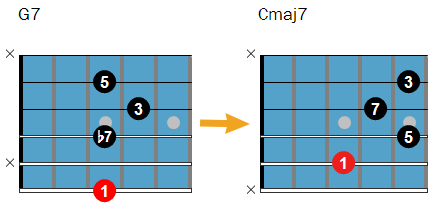
G7 to C6
C, Cmaj7, and C6 have the same function.
Cmaj7 has the 7th (b) added to the major triad, C6 has the 6th (a) added to the major triad.
C6 is a more stable chord than C maj7, which makes it a good chord to end tunes.
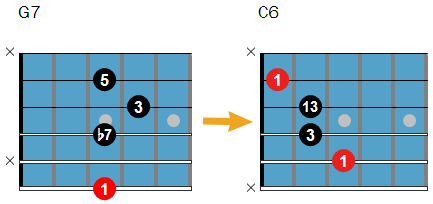
G7 to Cm7
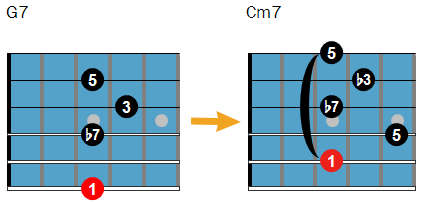
G7 to Am7
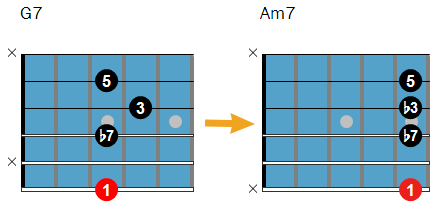
G7 to F#m7
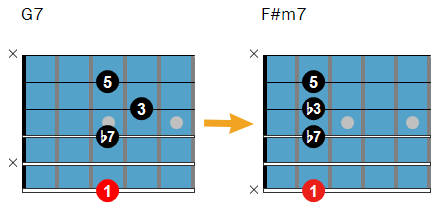
Secondary Dominant Chords
A secondary dominant chord (called “double dominant chord” by some) is the dominant of the dominant chord (V of V).
For example: we now know that the dominant chord of Cmaj7 is G7 and that dominant chords are built on the 5th scale degree. So if we want to find the dominant chord of G7, we should count 5 scale steps starting from G and make that chord dominant. The result is a D7 chord, the secondary dominant.
You can go further by finding the dominant of the secondary dominant. Counting 5 steps from D brings us to A7. Going even further, we’ll find the dominant of A7, which is E7, and so on…
Try to play these chords in sequence:
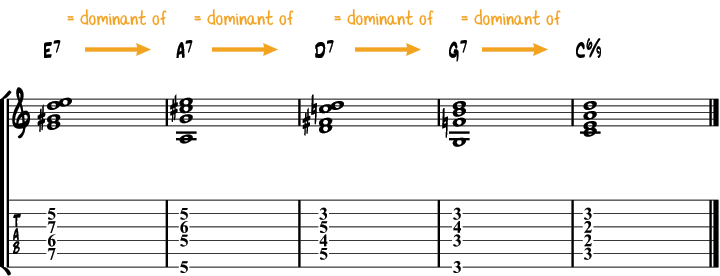
Dominant Chords In Blues
In blues music, all main chords are of the dominant type.
This means that in jazz blues chord progressions, the tonic, subdominant, and of course the dominant are all dominant-type chords (1 3 5 b7).
This is a result of the blue notes, notes that are sung at a slightly lower pitch than those of the major scale. The b7 (b3 and b5 are the others) is such a blue note and that’s why dominant chords are so prevalent in blues music.
To learn more about jazz blues guitar playing, have a look at our Introduction to Jazz Blues Guitar eBooks.
The post Dominant Chords appeared first on Jazz Guitar Online | Free Jazz Guitar Lessons, Licks, Tips & Tricks..
from Jazz Guitar Online | Free Jazz Guitar Lessons, Licks, Tips & Tricks. http://bit.ly/2WKkQpM
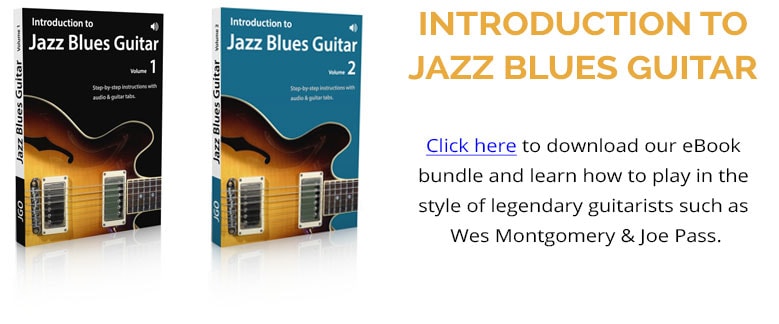
No comments:
Post a Comment